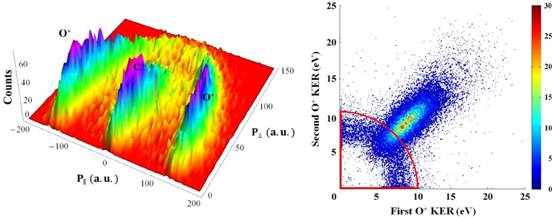Time:2013-03-10ClickTimes:
Investigating transient molecular structure is one of the fundamental tasks
in physics, chemistry and biology. Femtosecond laser coulomb explosion imaging
has been exhibited to be a feasible approach to monitoring transient molecular
structure, in which the molecule is rapidly ionized by intense femtosecond laser
field and the multiply charged molecular ion is quickly fragmented. The
molecular structure is then deduced from momentum vectors of correlated
fragments. However, this method still remains challenging for polyatomic
molecules because of their complicated fragmentation dynamics. The main question
lies in whether the chemical bonds break through a sequential or a
non-sequential process.

|
Very recently, Prof. Chengyin Wu, Prof. Qihuang Gong et al systematically
studied three-body fragmentation dynamics of carbon dioxide tri-cation in
intense femtosecond laser fields. Three-dimensional momenta were precisely
acquired for the three correlated atomic ions through three-body coincidence
measurement. Non-sequential and sequential fragmentation of carbon dioxide tri-cation
were precisely separated and unambiguously identified by developing kinetic
energy correlation diagram and Newton plot. With the high-level ab initio
potential of carbon dioxide tri-cation and accurate three-dimensional momentum
vectors of the atomic ions, the geometric structure of carbon dioxide tri-cation
before fragmentation was reconstructed, which turns out to be close to that of
the neutral carbon dioxide molecule before laser irradiation. The study
indicated that Coulomb explosion is a promising approach to imaging geometric
structures of polyatomic molecules if the fragmentation dynamics can be clearly
clarified and the accurate dissociation potential is provided for multiply
charged molecular ions. The work has been published by the Phys. Rev. Lett. (C.
Wu et al “Nonsequential and sequential fragmentation of CO23+ in intense laser
fields”, Phys. Rev. Lett. 110, 103601 (2013), http://prl.aps.org/abstract/PRL/v110/i10/e103601http://prl.aps.org/abstract/PRL/v109/i4/e043001).
